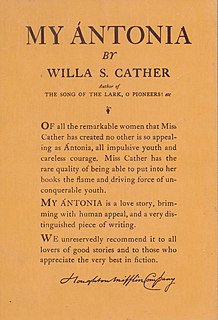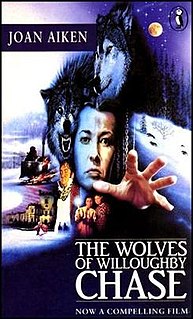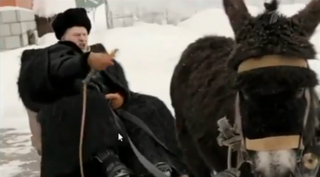
In Slavic folklore, Baba Yaga, also spelled Baba Jaga, is a supernatural being who appears as a deformed and/or ferocious-looking woman. In fairy tales Baba Yaga flies around in a mortar, wields a pestle, and dwells deep in the forest in a hut usually described as standing on chicken legs. Baba Yaga may help or hinder those that encounter or seek her out and may play a maternal role; she has associations with forest wildlife. According to Vladimir Propp's folktale morphology, Baba Yaga commonly appears as either a donor or a villain, or may be altogether ambiguous.

The Tar-Baby is the second of the Uncle Remus stories published in 1881; it is about a doll made of tar and turpentine used by the villainous Br'er Fox to entrap Br'er Rabbit. The more that Br'er Rabbit fights the Tar-Baby, the more entangled he becomes.

My Ántonia is a novel published in 1918 by American writer Willa Cather, considered one of her best works.

Sadko is the principal character in a Russian medieval epic bylina. He was an adventurer, merchant, and gusli musician from Novgorod.

"The Blizzard" is the second of five short stories that constitute The Tales of the Late Ivan Petrovich Belkin by Aleksandr Pushkin. The manuscript for the story was originally completed October 20, 1830. It was intended to be the last of The Tales of the Late Ivan Petrovich Belkin to be published, but Pushkin decided to push the story to the front of the volume. The novella, so comical and at the same time so dramatic, is considered to be one of the masterpieces of Russian literature.

The wolf is a common motif in the foundational mythologies and cosmologies of peoples throughout Eurasia and North America. The obvious attribute of the wolf is its nature of a predator, and correspondingly it is strongly associated with danger and destruction, making it the symbol of the warrior on one hand, and that of the devil on the other. The modern trope of the Big Bad Wolf is a development of this. The wolf holds great importance in the cultures and religions of the nomadic peoples, both of the Eurasian steppe and North American Plains.
The Prince Who Worked as Satan's Servant and Saved the King from Hell is a Lithuanian fairy tale collected by German linguists August Leskien and Karl Brugmann. Andrew Lang included it in The Grey Fairy Book under the title The Magician's Horse.
"Sleigh Ride" is a light orchestra standard composed by Leroy Anderson. The composer had formed the original idea for the piece during a heat wave in July 1946, and he finished the work in February 1948. The original recordings were instrumental versions. The lyrics, about riding in a sleigh and other fun wintertime activities, were written by Mitchell Parish in 1950. Anderson also made arrangements for wind band and piano.

A troika is a traditional Russian harness driving combination, using three horses abreast, usually pulling a sleigh. It differs from most other three-horse combinations in that the horses are harnessed abreast. The middle horse is usually harnessed in a horse collar and shaft bow; the side horses are usually in breastcollar harness. The troika is traditionally driven so that the middle horse trots and the side horses canter; the right-hand horse will be on the right lead and the left-hand horse on the left lead. The troika is often claimed to be the world's only harness combination with different gaits of the horses.

The Wolves of Willoughby Chase is a 1989 dark fantasy film directed by Stuart Orme with a screenplay by William M. Akers. The film was based on the 1962 novel of the same name, written by Joan Aiken.

On 6 February 2012, Vladimir Zhirinovsky, the former far-right populist leader of the nationalist Liberal Democratic Party of Russia, released a 30-second election video on the Internet that featured him on a sleigh which was harnessed with a black donkey. Zhirinovsky later claimed he owned the animal and that the animal was named Proshka, after Mikhail Prokhorov, another candidate in the 2012 Russian presidential election. The video was named "Troika" at the official site of the LDPR, but was distributed on YouTube under the title: "Zhirinovsky beats donkey!".

Folklore of Russia is folklore of Russians and other ethnic groups of Russia.
A Zmei Gorynich or zmei, in skazki and byliny, is a dragon or serpent, or sometimes a human-like character with dragon-like traits.
"Storm-Bogatyr, Ivan the Cow's Son" is a Russian fairy tale (skazka) #136 collected by Alexander Afanasyev in Narodnye russkie skazki, categorized as Aarne-Thompson type 300 A and 519.

Tristan Strong Punches a Hole in the Sky is a 2019 middle grade fantasy-adventure novel written by Kwame Mbalia. Published under the "Rick Riordan Presents" imprint, the novel is focused on African American folktales and West African mythology. The story follows teenager Tristan Strong, who is struggling with guilt after his best friend's death. Tristan accidentally creates a rift that transports him to Alke, a parallel world where myths are real, and must survive the evil forces that threaten Alke's people and discover his own abilities.
The Horse Lurja is a Georgian folktale about the friendship between a princess and a magic horse, which sacrifices itself for her after it rescues her from great peril. Although the tale appears in Georgia, some scholars recognize similar narratives in Central Asia.
The Tale about Baba-Yaga is a Russian fairy tale first published in a late 18th-century compilation of fairy tales.

Sivko-Burko is a Russian fairy tale (skazka) collected by folklorist Alexandr Afanasyev in his three-volume compilation Russian Fairy Tales.
The Swan Queen is a Lithuanian fairy tale related to the character of the swan maiden.













